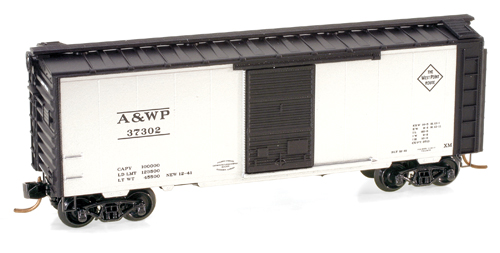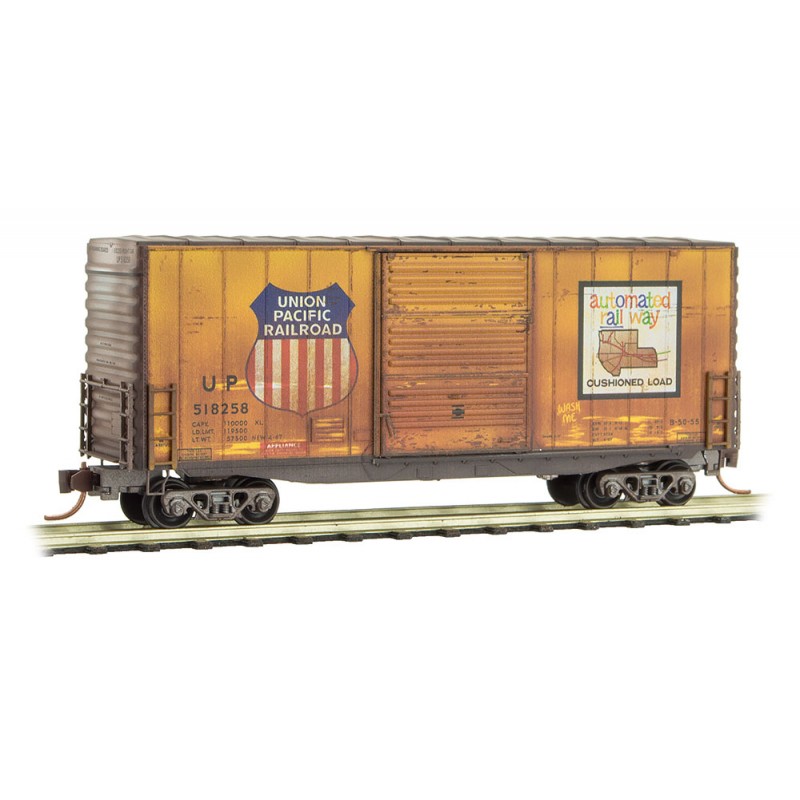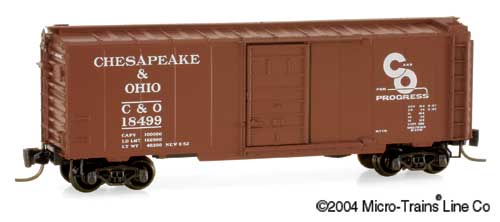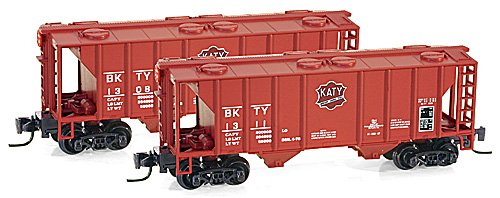Model Information: This is Micro-Trains first body style. It was introduced in 1972. Its is a model of a Pullman-Standard PS-1 boxcar from circa 1957. Micro-Trains does not market it as a PS-1 so as to allow themselves some latitude so they can use this car to model non-PS prototypes. Hundreds of different releases have used this body style in various paint schemes and road names. They are equipped with 6' sliding doors, either Youngstown (4/5/4 rib pattern) or Superior (7 panels). It is not a model of a "modern" steel boxcar as the length (40 foot) and the roofwalk are more typical of the transition era (1939 - 1957).
In 2019, Micro-Trains started releasing this model with new body-mounted couplers attached to a new underframe.
In 2019, Micro-Trains started releasing this model with new body-mounted couplers attached to a new underframe.
Prototype History: The 40' Boxcar is widely known as one of the most popular freight cars used by railroads as they transitioned from steam to diesel. In particular the Pullman Standard or PS-1 design was one of the most popular and was widely used by North American railroads. These boxcars were built beginning in 1947 and share the same basic design, with certain elements such as door size, door style or roof type varying among the different railroads and production years. When production of these cars ceased in 1963, over 100,000 had been produced.
So just what is a PS-1? Well the simple answer is it is any boxcar built by Pullman Standard from 1947 on. The design changed over the years – sometimes subtly, sometimes for customer request, and sometimes in a larger way. In general, most PS-1’s built from 1947 to 1961 share the same dimensions and basic construction techniques. These cars all had a length of 40′, a height of 10’5″ or 10’6″, welded sides and ends and roof of Pullman’s own design. The greatest variation was in the size and style of doors used. Pullman Standard also offered 50′ and later 60′ boxcars – also with the PS-1 designation.
So just what is a PS-1? Well the simple answer is it is any boxcar built by Pullman Standard from 1947 on. The design changed over the years – sometimes subtly, sometimes for customer request, and sometimes in a larger way. In general, most PS-1’s built from 1947 to 1961 share the same dimensions and basic construction techniques. These cars all had a length of 40′, a height of 10’5″ or 10’6″, welded sides and ends and roof of Pullman’s own design. The greatest variation was in the size and style of doors used. Pullman Standard also offered 50′ and later 60′ boxcars – also with the PS-1 designation.
Road Name History: 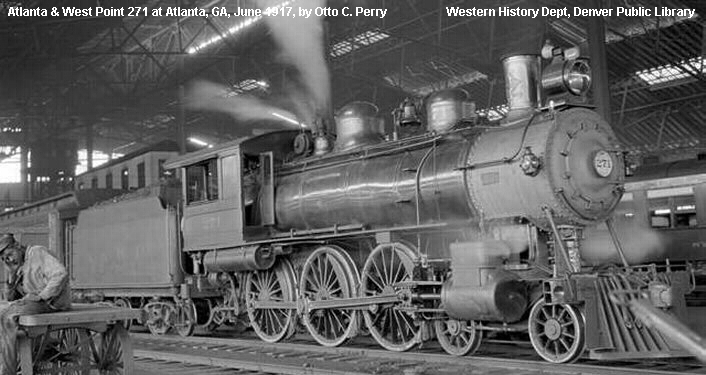 The A&WP was half of “The West Point Route” linking Atlanta, Georgia with Montgomery and Selma, Alabama. The A&WP covered the route from Atlanta 91 miles west to West Point on the Georgia-Alabama border. The other half of the West Point Route was the Western Railway of Alabama (or WofA for short.) Both West Point Route roads were controlled by the Georgia Railroad since the 19th century. It was common for locomotives of all three roads to be seen on each other’s lines. A&WP was the smallest of the three and had a fleet of just a dozen locomotives. Despite that, operations had a very “mainline” appearance.
The A&WP was half of “The West Point Route” linking Atlanta, Georgia with Montgomery and Selma, Alabama. The A&WP covered the route from Atlanta 91 miles west to West Point on the Georgia-Alabama border. The other half of the West Point Route was the Western Railway of Alabama (or WofA for short.) Both West Point Route roads were controlled by the Georgia Railroad since the 19th century. It was common for locomotives of all three roads to be seen on each other’s lines. A&WP was the smallest of the three and had a fleet of just a dozen locomotives. Despite that, operations had a very “mainline” appearance.
The pride of the A&WP steam fleet included a half dozen heavy Mikados for freight and four Pacifics for passenger service. The replaced a fleet of nine 4-6-0’s and a single Mogul out on the road. 0-6-0’s and 0-8-0’s did the switching. The A&WP was fully dieselized in 1952. A&WP’s passenger service claim to fame was the Southern Railway’s Crescent, a New York to New Orleans train that traveled the entire length of the A&WP. This routing (which also included WofA and L&N) was preferred because it was shorter than an all-Southern Railway route and it served the Montgomery and Selma areas. This train ran until 1970. Since A&WP’s parent Georgia Railroad was controlled jointly by L&N and Seaboard Coast Line (previously ACL,) they all gradually adopted the Family Lines image in the 1970s. In 1983, all of the Family Lines roads were combined into Seaboard System.

The pride of the A&WP steam fleet included a half dozen heavy Mikados for freight and four Pacifics for passenger service. The replaced a fleet of nine 4-6-0’s and a single Mogul out on the road. 0-6-0’s and 0-8-0’s did the switching. The A&WP was fully dieselized in 1952. A&WP’s passenger service claim to fame was the Southern Railway’s Crescent, a New York to New Orleans train that traveled the entire length of the A&WP. This routing (which also included WofA and L&N) was preferred because it was shorter than an all-Southern Railway route and it served the Montgomery and Selma areas. This train ran until 1970. Since A&WP’s parent Georgia Railroad was controlled jointly by L&N and Seaboard Coast Line (previously ACL,) they all gradually adopted the Family Lines image in the 1970s. In 1983, all of the Family Lines roads were combined into Seaboard System.
Brand/Importer Information: Micro-Trains is the brand name used by both Kadee Quality Products and Micro-Trains Line. For a history of the relationship between the brand and the two companies, please consult our Micro-Trains Collector's Guide.
Manufacturer Information:  Micro-Trains Line split off from Kadee Quality Products in 1990. Kadee Quality Products originally got involved in N-Scale by producing a scaled-down version of their successful HO Magne-Matic knuckle coupler system. This coupler was superior to the ubiquitous 'Rapido' style coupler due to two primary factors: superior realistic appearance and the ability to automatically uncouple when stopped over a magnet embedded in a section of track. The success of these couplers in N-Scale quickly translated to the production of trucks, wheels and in 1972 a release of ready-to-run box cars.
Micro-Trains Line split off from Kadee Quality Products in 1990. Kadee Quality Products originally got involved in N-Scale by producing a scaled-down version of their successful HO Magne-Matic knuckle coupler system. This coupler was superior to the ubiquitous 'Rapido' style coupler due to two primary factors: superior realistic appearance and the ability to automatically uncouple when stopped over a magnet embedded in a section of track. The success of these couplers in N-Scale quickly translated to the production of trucks, wheels and in 1972 a release of ready-to-run box cars.
Micro-Trains Line Co. split off from Kadee in 1990 to form a completely independent company. For this reason, products from this company can appear with labels from both enterprises. Due to the nature of production idiosyncrasies and various random factors, the rolling stock from Micro-Trains can have all sorts of interesting variations in both their packaging as well as the products themselves. When acquiring an MTL product it is very important to understand these important production variations that can greatly enhance (or decrease) the value of your purchase.
Please consult our Micro-Trains Collector's Guide

Micro-Trains Line Co. split off from Kadee in 1990 to form a completely independent company. For this reason, products from this company can appear with labels from both enterprises. Due to the nature of production idiosyncrasies and various random factors, the rolling stock from Micro-Trains can have all sorts of interesting variations in both their packaging as well as the products themselves. When acquiring an MTL product it is very important to understand these important production variations that can greatly enhance (or decrease) the value of your purchase.
Please consult our Micro-Trains Collector's Guide
Item created by: Lethe on 2015-05-31 17:46:30. Last edited by George on 2024-01-26 20:28:45
If you see errors or missing data in this entry, please feel free to log in and edit it. Anyone with a Gmail account can log in instantly.
If you see errors or missing data in this entry, please feel free to log in and edit it. Anyone with a Gmail account can log in instantly.


